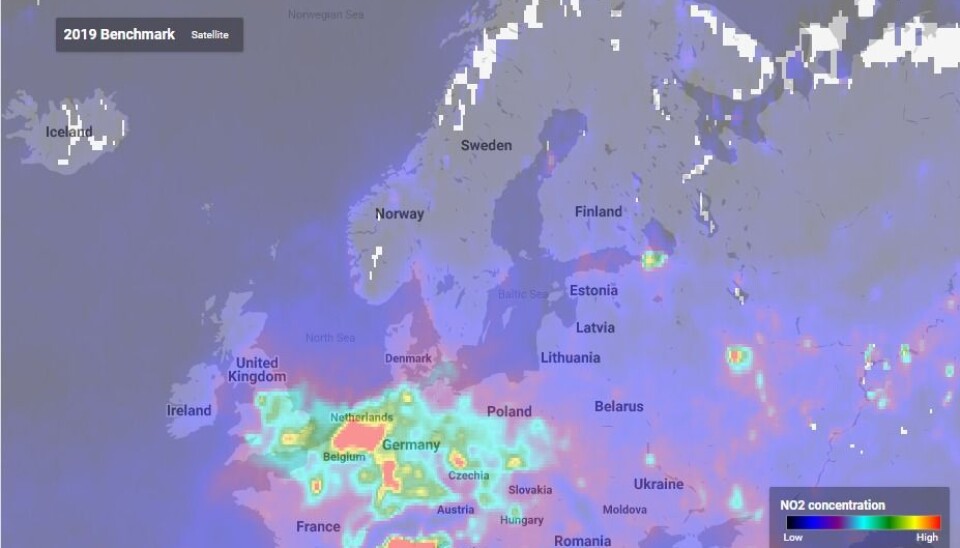This article is produced and financed by University of Oslo - read more

Global air pollution levels drop amid COVID-19 lockdown
The decline of air pollution due to COVID-19 lockdowns is surprisingly high. It demonstrates that it is possible to rapidly reduce environmental pollution for the benefit of human health, even though we need to find more sustainable ways to do so.
“We knew that the COVID-19 lockdown had caused an unprecedented reduction in global economic and transport activity. But we wanted to test whether this actually had affected the concentrations of different air pollutants, and what were the changes in different countries” says Kristin Aunan, senior researcher at, Center for International Climate Research and leader of the project EXHAUSTION,
Together with researchers from the Max Planck Institute for Chemistry in Germany Aunan recently published an article in the journal Proceedings of the National Academy of Sciences (PNAS).
The pollutants included in the study were nitrogen dioxide (NO2), fine particulate matter (PM2.5) and Ozone (O3). These are commonly measured air pollutants, arising from transport, industry and other sources typically found in densely populated areas.
Air pollutants cause asthma, heart- and lung diseases
“All these pollutants have negative health effects, such as asthma, heart- and lung diseases, kidney-problems etc. Pollution even affects our brain”, says Aunan.
“There are many vulnerable groups, but it is particularly worrisome when children are exposed to high levels of air pollutants as their lungs and brains are still developing”, Aunan explains.
See video on air pollution and the COVID 19 lockdowns here:
Significant reduction in nitrogen dioxide concentration
Measurements from more than 10 000 air quality stations in 34 different countries were analysed, in addition to satellite data. The findings were clear: There was a convincing correlation between lockdowns and the decline of some of the health-damaging air pollutants.
Because weather patterns may strongly affect the ground-level concentration of air pollutants, the researchers adjusted the pre-COVID-19 (2017-2019) observations by taking into account temperature, humidity, precipitation and wind speed to come up with benchmark estimates of pollution during lockdown dates.
Zander Venter, a researcher at the Norwegian Institute for Nature Research, has also contributed to the study.
“The benchmark concentrations are estimates of what the levels would have been given no lockdown policies and the actual weather during the relevant time of the year. In this way we were able to estimate the anomalies that could be attributed to the lockdown,” explains Venter.
Relevant in a health context “Whereas we do not present any estimates of potentially avoided health damage in the current paper, we wanted to provide estimates that are relevant in a health context”, says Aunan.
Reductions is highest in highly populated regions
To calculate health damage from air pollution on a population basis, you need to have so-called population-weighted estimates of the pollution levels. This means that the number of people being exposed to different levels of air pollution is taken into account.
Not surprisingly, the study found that the reductions during lock-down were largest in highly populated regions. Taking this into account, the study found that the average decline in exposure was around 60 per cent for nitrogen dioxide (NO2). Particular matter (PM2.5) also decreased during lockdown, but less, i.e. by 31 percent. The researchers also looked at a third air pollutant, ground-level ozone (O3), a photochemical oxidant. In most of the countries studied, ozone levels increased during the lockdown period.
“The reason for this is linked to the chemical relationship between the different air pollutant species. When NO2 goes down, very often the concentration of ozone goes up, particularly close to emission sources, i.e. in urban areas”, Aunan explains. The pattern with reduced levels of nitrogen dioxide and increased levels of ozone was evident in a majority of the countries in the study.
The results from each of the 34 countries can be seen on this website: https://nina.earthengine.app/view/lockdown-pollution

Mobility data shows reduction of vehicle transportation
The PNAS study was quite innovative when it comes to the data that were used.
“We used mobility data from Google and Apple and found a clear association between the declining ambient NO2 concentrations and reduction of vehicle transportation”, says Venter.
In this way the researchers were able to pinpoint the likely main cause of the large reductions in population-weighted NO2 concentration.
“We conclude that maintaining business as usual clearly exacerbates global pollutant emissions and the level of exposure amongst people. However, a lockdown due to a pandemic is of course not how we recommend to reduce air pollution levels,” Venter and Aunan agrees.
Solutions to reduce air pollution
Onwards, the interesting thing to follow is how governments, businesses, local communities and individuals act when the pandemic loosens its grip and societies strive to ramp up the economy. Will any of the changes that have reduced air pollution emissions, such as less traveling, be maintained or will things get back to how it was, or even worse in terms of emissions?
“For the sake of public health, there will hopefully be some learning and positive impacts”, says Aunan.
The study provides justification for city-level initiatives to promote public transport systems as well as pedestrian and cycling activity, so that its inhabitants become less exposed to the negative health effects from air pollution.
“To obtain the decline in air pollution that was observed during COVID-19 lockdown, it will also be necessary to find economically and socially sustainable alternatives to fossil fuel use in industries, transportation, power plants, and cleaner fuels for use in households”, Venter concludes.
Reference:
Venter, Zander S. et al, COVID-19 lockdowns cause global air pollution declines, PNAS, 2020


































